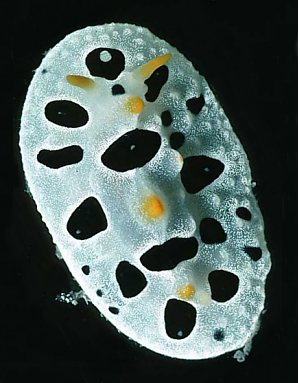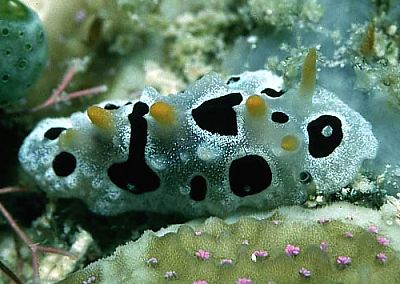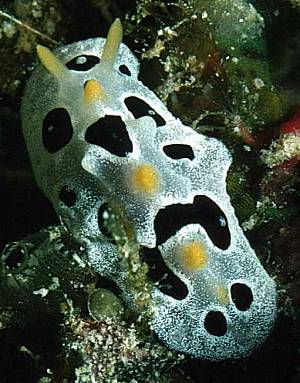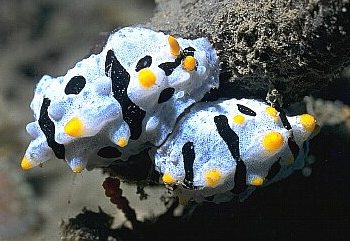
Phyllidia cf. babai
Brunckhorst, 1993
Order: NUDIBRANCHIA
Suborder: DORIDINA
Superfamily: EUDORIDOIDEA
Family: Phyllidiidae
PHOTO
Bali, Indonesia, April 1989, 25mm long. Photo: B.E.Picton.
I have out on this page a number of puzzling animals which don't fit well into any described species. If they are all the same they may be P. babai or P. willani or even Fryeria marindica. It is possible they are not all the same species.
Reference:
• Brunckhorst, D.J. (1993) The systematics and phylogeny of Phyllidiid Nudibranchs(Doridoidea). Records of the Australian Museum, Supplement 16: 1-107.
Rudman, W.B., 2002 (June 27) Phyllidia cf. babai Brunckhorst, 1993. [In] Sea Slug Forum. Australian Museum, Sydney. Available from http://www.seaslugforum.net/find/phylcfbaba
Related messages
Re: Fryeria marindica from the Phillipines
June 30, 2002
From: Bernard Picton

Hi Bill,
I don't think the animal from the Philippines is Fryeria marindica. I was about to write and say it was Phyllidia babai, as that is what I was calling animals looking like this, but then I reread Brunckhorst and think I was wrong in my identifications. I've attached scans of two animals, one from Bali and one from Hoga, SW Sulawesi. To me they are intermediate between Phyllidia babai and Phyllidia willani. The black markings have a quite regular basic plan - a single central one at the front, then a pair of rounded marks, then a central mark flanked by two others, (which may join with it to form a continuous band in the Phillipines material?), then two lateral ones again, then another three (or band - see Hoga specimen) then two. There is a scattering of white spots which get denser along the edges of the black markings. There are three tall, orange-tipped tubercles down the middle of the back.
Bob Bolland has an animal like a larger version of this on his website as Phyllidia babai. I wonder what you make of it?
Upper/Lower Right: Hoga, Sulawesi, Indonesia Sept 1997 - 20mm
Lower left: Bali, Indonesia, April 1989 - 25mm
Bernard
bernard.picton.um@nics.gov.uk


Thanks Bernard,
I can certainly see the pattern of colours and tubercles you mention, and Bob Bolland's animal also fits. I have difficulty differentiating P. babai from P. willani. My feelings on the animal from the Philippines was partially based on the distinctive bluish tinge to the mantle. As far as I know neither P. babai nor P. willani have been reported to have a blue colour phase, they are always covered with a heavy dusting of white specks on a translucent background.
Certainly the distinctive tubercle pattern in the middle of the back that you describe is unlike either species. I think I will put then on a separate page as Phyllidia cf. babai, at least temporarily, until we get some more information on them.
Cheers,
Bill Rudman
Record of Fryeria marindica from the Phillipines
June 22, 2002
From: Fredy Brauchli

Hello Bill
As you wrote earlier, Fryeria and Phyllidia might be difficult to separate. I suppose that this record shows Fryeria marindica, even if it is from Pandan Isl., Occ. Mindoro, Philippines. Do you agree?
Size: ca. 3 cm, depth: 10m, place: Neptun's Land, date: March 31st 2002.
Kind regards,
Fredy
http://www.subaqua.ch
brauchli@subaqua.ch
Brauchli, F., 2002 (Jun 22) Record of Fryeria marindica from the Phillipines. [Message in] Sea Slug Forum. Australian Museum, Sydney. Available from http://www.seaslugforum.net/find/7114Dear Fredy,
Some things are certainly difficult to be sure about when I have only a dorsal photo to look at, such as the position of the anus and whether there is a black median line on the sole of the foot. However, even though the black markings are more sparse than normal, I would agree with you, that this certainly looks like F. marindica. As this is supposed to be an Indian Ocean endemic ['marindica' = Indian Ocean], your find is quite interesting. It looks similar to Atsushi Ono's photo from Japan.
It will certainly be useful to build up more information on the geographic distribution of the various species of Fryeria which Brunckhorst (1993) proposed had discrete geographic boundaries, species replacing each other in different parts of the Indo-West Pacific.
Best wishes,
Bill Rudman
